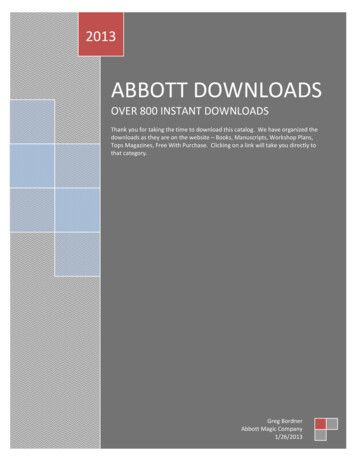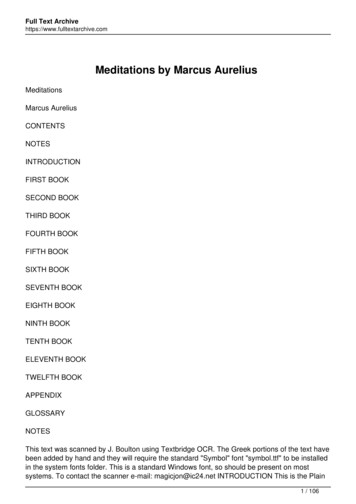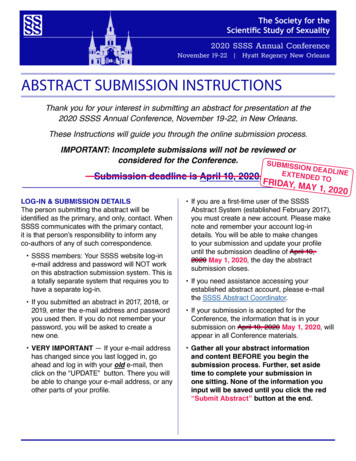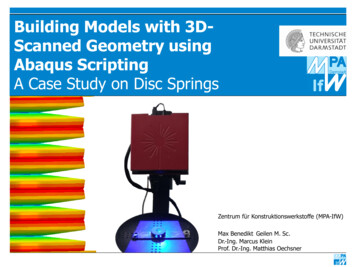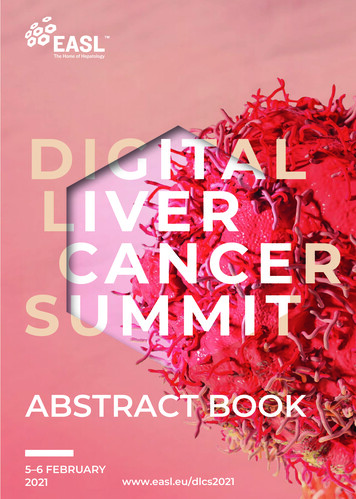
Transcription
ABSTRACT BOOK5–6 FEBRUARY2021www.easl.eu/dlcs2021
ContentsORAL POSTER ABSTRACT PRESENTATIONSO01 Genetic and epigenetic analyses reveal early and distinct alterations in intraductal papillary andtubulopapillary cholangiocarcinogenesis.8O02YI CRISPR screening in intrahepatic cholangiocarcinoma.9O03YI Is progression-free survival a robust surrogate endpoint of overall survival in immunotherapytrials of hepatocellular carcinoma? .11O04 A phase II study of stereotactic body radiotherapy (SBRT) combined with sintilimab in patientswith oligometastases of hepatocellular carcinoma (HCC) .13O05 IMbrave150: updated overall survival (OS) data from a global, randomized, open-label Phase IIIstudy of atezolizumab (atezo) bevacizumab (bev) vs sorafenib (sor) in patients (pts) withunresectable hepatocellular carcinoma (HCC) .14O06YI Identifying effective subtype-specific treatment responses in hepatocellular carcinoma ingenetically engineered mouse models .15O07 Immunological alterations induced by HBV-TCR T cell immunotherapy associates with treatmentresponse of primary HBV related-HCC. .17O08YI Non-autonomous induction of endothelial Rela underpins immune-mediated surveillance ofpremalignant hepatocytes .18P001YI Surgery versus Sorafenib in case of BCLC-C hepatocellular carcinoma: an Italian weightedstudy.21P002YI Current Trends of Hepatocellular Carcinoma Characteristics in Greece.23P003 Patterns of response to atezolizumab (atezo) bevacizumab (bev) in hepatocellular carcinoma(HCC) from the Phase 1b GO30140 study.24P004YI Association between serum magnesium concentration and hepatocellular carcinoma incirrhotic patients.26P005YI The best potential treatment for recurrent hepatocellular carcinoma after surgery: a machinelearning predictive model for treatment allocation based on an Italian multicentric database .28P006YI Cholangiocarcinoma progression depends on the uptake and metabolization of extracellularlipids .30P007 Sequential Treatment of Sorafenib-Regorafenib versus Sorafenib-Physician’s Choice: APropensity Score Matched Analysis .31P008 Study on Regorafenib Combined with Transcatheter Arterial Chemoembolization in theTreatment of Advanced Hepatocellular Carcinoma after First Line Targeted Therapy .33P009YI Hepatocellular carcinoma prognostic scores: filling the gap? .36P010 A real-world evaluation of baseline characteristics, treatment patterns, and survival outcomes inpatients with advanced hepatocellular carcinoma and elevated baseline alpha-fetoprotein levelsreceiving second-line therapy in the United States.38P011YI Increased platelet aggregation in patients with cirrhosis and hepatocellular carcinoma: a newpotential therapeutic target? .39P012 Comparison of Sorafenib and Lenvatinib as first line therapy in Unresectable Hepatocarcinoma:a multi-center propensity score matching analysis .41P013YI chronic hepatitis b under tenofovir or entecavir: performance of the page-b score to predicthepatocellular .44P014YI Diagnosing hepatocellular carcinoma – are we ‘getting it right first time’? .45P015 Modeling hepatocellular carcinoma cells dynamics by serological and imaging biomarkers inpatients with response to sorafenib and/or regorafenib .46P016YI Profiling of cell-free DNA using Whole-exome sequencing in patients with Hepatocellularcarcinoma in Thailand .48Digital Liver Cancer Summit, 5-6 February 20211
P017YI Transcriptomic analyses reveal cancer-induce genes in PBMCs of Hepatocellular carcinomafor early diagnosis and prognosis .49P018YI Association between postoperative early recurrence of hepatocellular carcinoma and theexpression pattern of circulating tumor cells in peripheral blood sample: a preliminary study. .50P019YI Circulating prostaglandin E2: a novel potential prognostic biomarker in patients withhepatocellular carcinoma .52P020 Establishment of 3D-organoids from cryopreserved cancer tissues .54P021YI Prognostic role of platelets-to lymphocytes ratio (PLR) and neutrophils-to-lymphocytes ratio(NLR) in hepatocellular carcinoma patients .55P022YI Impact of hospital volume on hepatocellular carcinoma survival in Italy .56P023YI Sarcomatoid hepatocellular carcinoma has distinct immunologic hallmarks from ordinaryhepatocellular carcinoma .58P024 Characteristics of patients who received regorafenib for unresectable hepatocellular carcinomain routine clinical practice: interim analysis of the prospective, observational REFINE study .59P025 Radiofrequency ablation versus surgical resection for the treatment of solitary hepatocellularcarcinoma 2cm or smaller: a cohort study in Taiwan.60P026 Outcomes based on albumin-bilirubin grade in the phase 3 RESORCE trial of regorafenib versusplacebo in patients with advanced hepatocellular carcinoma .62P027YI Phenotypic characteristics of the tumour microenvironment in primary and secondaryhepatocellular carcinoma. .64P028YI Are undetected stones in the common biliary duct one of the causes of abscesses andbilomas development after percutaneous thermal ablation procedures? .65P029YI Different modalities in management of bleeding related to post-banding ulcer followingendoscopic variceal ligation in cirrhotic patients with or without hepatocellular Carcinoma .66P030 Copper chelators old drugs for new uses in the treatment of hepatocellular carcinoma .69P031YI Diagnostic accuracy of a-fetoprotein (AFP), protein induced by vitamin K absence (PIVKA-II)and fibrogen like protein-2 (FGL-2) for HCC diagnosis among patients with liver cirrhosis.70P032YI NADPH oxidase 4 (Nox4) deletion accelerates liver regeneration in mice .71P033YI Development of ex vivo and in vivo tissue models of hepatocellular carcinoma and utility forimmunotherapy investigations .73P034YI Methylated Septin 9 (mSEPT9) as a biomarker for hepatocellular carcinoma. Results fromUniversity Hospital Coventry and Warwickshire NHS Trust, UK .74P035 Impact of NAFLD on clinical outcomes in hepatocellular carcinoma treated with sorafenib: aninternational cohort study .76P036 Trans-arterial chemoembolization as a loco-regional inducer of immunogenic cell death inhepatocellular carcinoma: implications for immunotherapy. .78P037 PNPLA3 and Notch3 gene polymorphisms as risk factors for alcoholic cirrhosis development andits progression to hepatocellular carcinoma .79P038YI Urinary volatile organic compounds characterization in hepatocellular carcinoma – pilot study.80P039YI Comparison of incidence and mortality risks due to acute kidney injury in hepatocellularcarcinoma patients after liver resection, ablation, and transarterial chemoembolization: Meta-analysisof cohort studies .82P040YI Predictive value of biomarkers a-fetoprotein (AFP) and fibrogen like protein-2 (FGL-2) for HCCamong patients with liver cirrhosis .83P041YI Transarterial chemoembolization: Predictors of liver function deterioration prior tohepatocellular carcinoma refractoriness .84P042YI Two birds one stone: a case of synchronous hepatocellular carcinoma and intrahepaticcholangiocarcinoma .85Digital Liver Cancer Summit, 5-6 February 20212
P043YI Virtual biopsy for diagnosis of steatohepatitis and chemotherapy-associated liver injuries. Acombined radiomic and clinical model. .86P044 Pattern of progression of intrahepatic cholangiocarcinoma influences survival: implications forsecond-line trials .88P045YI Hepatic and extrahepatic colorectal metastases have discordant responses to systemictherapy. Pathology data from patients undergoing simultaneous resection of multiple tumor sites. 90P046 A phase Ib study of pembrolizumab following trans-arterial chemoembolization (TACE) inhepatocellular carcinoma (HCC): PETAL.92P047YI Hsa-miR-21-5p disturbs the liver metabolic network in patients with NAFLD and is increased inNASH-associated HCC, contributing to hepatocarcinogenesis in mice.93P048YI Balloon occluded TACE (B-TACE) vs DEM-TACE for HCC. A single center retrospective casecontrol study. .94P049YI Perfusion analysis with dynamic contrast enhanced ultrasound for the diagnosis ofhepatocellular carcinoma: a pilot study of a novel parameter aiming to improve the detection of washout .96P050 Chronic disruption of the late cholesterol synthesis leads to female-prevalent liver cancer .98P051 Real-life clinical data of cabozantinib for unresectable hepatocellular carcinoma: efficacy, safety,and prognostic factors. .100P052YI Human antigen R (HuR) SUMOylation is a fine-tuner of hepatocellular carcinoma(HCC) progression via the modulation of key mitochondrial mRNAs .101P053 GALAD Score shows improved detection of early stage hepatocellular carcinoma in a Caucasiancohort of chronic Hepatitis B and C .103P054YI Evaluation of cardiovascular events in patients with hepatocellular carcinoma treated withsorafenib in the clinical practice: CARDIO-SOR study. .105P055YI Treatment of the chemotherapy induced hepatotoxicity .106P056YI Serum miRNA profiling for the differential diagnosis of distal cholangiocarcinoma frompancreatic diseases .107P057 Hepatocellular Carcinoma Surveillance in Cirrhotic patients. .108P058YI Dynamic risk profile of hepatocellular carcinoma recurrence after curative intent liver resection.110P059YI Targeting tumor-initiating cells and compensatory YAP pathway activation to overcomesorafenib-induced resistance in hepatocellular carcinoma .112P060 Immunosuppressive Drug Resistant Armored TCR T cells for immune-therapy of HCC in livertransplant patients.113P061YI Circular RNA expression is modulated by RNA-binding proteins in hepatocellular carcinoma.115P062 The impact of ultrasonographic blind spots for detecting early-stage hepatocellular carcinomaduring surveillance .116P063 Prognostic factors and post-treatment survival in patients enrolled onto second-line trials forunresectable hepatocellular carcinoma after sorafenib: a multicentre Italian cohort study .117P064YI FGFR2 fusion protein-driven mouse models of intrahepatic cholangiocarcinoma unveil anecessary role for Erk signaling.118P065 Phase 1 study of autologous hepatitis B virus (HBV)-specific T cell receptor (TCR) T-cells,LioCyx-M in unresectable HBV-related hepatocellular carcinoma (HCC).119P066YI The combination of alcohol and metabolic syndrome is a fast track to hepatic tumorigenesis.121P067YI Thyroid disease and hepatocellular carcinoma survival. A Danish nationwide cohort study. 122P068YI Usefulness of circulating tumor cells in the management of patients with hepatocellularcarcinoma .124Digital Liver Cancer Summit, 5-6 February 20213
P069YI Prognostic value of metabolic imaging data of ¹¹C-choline PET/CT in patients undergoinghepatectomy for hepatocellular carcinoma.126P070 First real-life experience with atezolizumab plus bevacizumab in the treatment of advancedhepatocellular carcinoma .128P071 Extracellular signal-regulated kinase 5 regulates the malignant phenotype ofcholangiocarcinoma cells .129P072YI Alteration of miRNA content in extracellular vesicles in Sorafenib-treated liver cancer cells.miRNA prognostic value in plasma from patients with advanced HCC treated with Sorafenib .130P073 Virological and oncological factors of HCC recurrence after liver trasplantation in a singletransplant center .132P074YI Dynamics of endothelial progenitor cells in patients with advanced hepatocellular carcinoma.133P075YI Tumor Burden Score: a novel tool to predict immune-related liver injury during immunotherapyfor hepatocellular carcinoma .134P076 Phase 3 KEYNOTE-937 Trial: Adjuvant Pembrolizumab for Hepatocellular Carcinoma andComplete Radiologic Response After Surgical Resection or Local Ablation .136P077YI PRPF8 regulates FAK/AKT pathway via fibronectin 1 splicing modulation to promotehepatocellular carcinoma aggressiveness .137P078YI Retrospective analysis of one-center experience in diagnosis and treatment of liver cancer 138P079 Analysis of risk factors associated with hepatocellular carcinoma development in patients withhepatitis B virus infection.139P080YI Serum levels of CXCL13 are an independent predictor of survival following resection of biliarytract cancer .140P082YI In vivo quantification of micro-balloon interventions (MBI) advantage. Cohort, retrospective, bicentric study of DEB-TACE vs b-TACE and SIRT vs b-SIRT .143P083 Comparison of Liver Transplant Criteria for Hepatocellular Carcinoma .146P084 LDH as early prognostic markers for response in advanced hepatocellular carcinoma treatedwith Nivolumab .150P085YI DNA Methyltransferases as Potential Biomarkers for Egyptian Patients with HCV RelatedHepatocellular Carcinoma .152P086YI Survival analysis of the most frequent Single Nucleotide Variants in Hepatocellular Carcinoma.153P087YI Se and Zn supplements attenuates HCC among recovered Hepatitis C Obese population inMiddle Belt Nigeria. .155P088YI CAMD score predicts the risk of hepatocellular carcinoma in Tunisian patients with chronichepatitis B on antiviral therapy .156P089 Centrality of Estrogen Receptor 1 in Modulating Hepatocellular Carcinoma Progression throughWnt signaling .157P090YI Hepatoprotective effects of pirfenidone in early stages of hepatocellular carcinoma .159P091 Real-world experience of hepatocellular carcinoma patients after sorafenib treatment: eligibilityto subsequent lines and prognostic factors. .161P092 Hepatotoxicity in patients with hepatocellular carcinoma on treatment with immune checkpointinhibitors .162P093YI Identification of a prognostic 3-protein score of childhood liver cancer by proteomic profiling.163P094YI Pattern of macrovascular invasion in patients with hepatocellular carcinoma influencestreatment and outcome. .164P095 Quantification of extracellular matrix features and its implications in hepatocellular carcinomapatients after curative liver resection .166Digital Liver Cancer Summit, 5-6 February 20214
P096YI Enhanced mitochondrial activity and immunometabolic reprogramming, by silencingMethylation Controlled J protein (MCJ), accelerates liver tumorigenesis in a hepatocellular carcinoma(HCC) mice model .168P097YI Absence of a complete response after two trans-arterial chemo-embolizations during livertransplantation waiting list: should we persist or change? .170P098 Prediction of early recurrence of hepatocellular carcinoma after resection: international validationof the ERASL risk models .172P099 Equal overall survival in elderly patients with hepatocellular carcinoma receiving palliativetreatment .174P100 PD-1 expression, polymorphisms in PDCD1 and hepatocellular carcinoma (HCC) in patients withnon-alcoholic fatty liver disease (NAFLD). .175P101YI Is first- and second-line immunotherapy sequence the optimal strategy for unresectablehepatocellular carcinoma? .177P102YI Circulating miR 373 but not miR 210 as a new promising preoperative predictor of response tosuperselective transarterial chemoembolization bridging therapy in Egyptian patients withhepatocellular carcinoma on top of hepatitis C virus infection .179P103 Systematic review and meta-analysis of validated prognostic models for resected hepatocellularcarcinoma patients .181P104 Levels of circulating PD-L1 are decreased in patients with resectable biliary tract cancer (BTC).183P105YI Endothelial Angiopoietin-2 overexpression in explanted HCCs identifies subjects at high risk ofrecurrence after liver transplant .184P106YI Role of LI-RADS indeterminate observations in the prediction of HCC occurrence after directantiviral therapy for hepatitis C virus infection. .186P107YI lncRNA-H19 as a marker of liver disease progression: Hepatocellular Carcinoma .187P108 Nanobody-targeted liposomes for photodynamic therapy of Cholangiocarcinoma .188P109YI Effectiveness of hepatocellular carcinoma treatments with curative intent: a nationwide study.190P110YI Epidemiological trends of hepatocellular carcinoma in patients with Metabolic-DysfunctionAssociated Fatty Liver Disease (MAFLD) in Italy. .192P111 An unexpected side effect of lenvatinib in patients treated for advanced hepatocellularcarcinoma: increased hemoglobin level and erythrocytosis .193P112YI Are Radiology-based endpoints robust surrogate outcomes of overall survival inhepatocellular carcinoma patients treated with transarterial chemoembolization? .195P113 Vimentin expression in hepatocellular carcinoma relates with progenitor cells and epithelialmesenchymal transition carcinogenesis .196P114YI Inducing tissue-resident gamma delta T cells for immunotherapy of hepatocellular carcinoma.197P115YI Nurse intervention optimizes the care of patients with hepatocellular carcinoma undersystemic treatment .198P116 A circulating microRNAs signature identifies DAA-treated HCV-related cirrhosis patients at highrisk to develop HCC .199P117 Cancer-associated pathways modulated by O-GlcNAc transferase and Enhancer of Zestehomolog 2 in hepatocellular carcinoma.200P118YI Assessment of the impact of COVID-19 pandemic on Liver Cancer Management (CERO-19).201P119YI Modified Page B Score Performance in Predicting HCC Risk in patients with chronic hepatitisB on antiviral therapy. .204Digital Liver Cancer Summit, 5-6 February 20215
P120 Circulating microRNAs predict hepatocellular carcinoma in NUC-suppressed HBV cirrhoticpatients .205P121YI Liver decompensation as late complication in HCC patients with long term response followingselective internal radiation therapy. .206P122YI Prognostic performance of Toronto HCC risk index and the alpha-fetoprotein rate in patientswith Hepatocellular carcinoma .207P123YI Safety and benefit of the combination of regorafenib and nivolumab in patients withhepatocellular carcinoma (HCC) in progression beyond two lines of oral chemotherapy .208P125YI Performance of ten non-invasive liver function tests in predicting one-year mortality in patientswith hepatocellular carcinoma .211P126 Impact of Hepatocellular Carcinoma screening in patients with Non-Achoholic Fatty LiverDisease and survival analyzis: a Brazilian Cross-Section Study.212P127YI Whole-transcriptome profiling of biopsies from unresectable intrahepatic cholangiocarcinoma(iCCA) reveals a prognostic signature with treatment implications. .214P128 Complete response after biological downstaging in patients with hepatocellular carcinoma: XXLlike prioritization for liver transplantation or “waiting and see” strategy? .216P129YI PSMA PET/CT imaging has equivalent performance to MRI for characterising hepatocellularcarcinoma .
Digital Liver Cancer Summit, 5-6 February 2021 6

